Crossing the Thai-border to Angkor, Cambodia, 2005
Jan 19 (Bangkok)
To rush clearing my remaining work leaves soon, I made a quick decision to take a trip to Angkor, the architectural wonder in Cambodia, on a tour package of 12 other Singaporeans. Hence, believe it or not, a week after our Langkawi idyllic trip, we flew again by ValuAir. Comparing to the tour package of fixed itinerary, Cheng, my wife and I found ourselves not as enthusiastic as in the free-and-easy type, yet we were optimistic in trying anything first time. For example, being a novice in taking budget airline, I was hoping for a free soft drink when the stewardess handed to me smilingly. I knew nothing in the first place that a service smile and a can drink were not included in the already cheap airfare package, so not to embarrass myself in front of the waiting stewardess, I was compelled to folk the note out. Nevertheless, the trip was made safer in a first-handed air plane with extra-friendly cabin crews as well as decent finger foods.
At the Bangkok International Airport, a 20-something Thai tour guide, bespectacled and radiant, named Ning, liased with us to a supreme coach bus. I was glad to travel on the comfortable bus, expecting the Cambodia ride would be bumpy and long in days to come. During the ride, she introduced about Bangkok and gave tips on where and what to buy in this shopping paradise. Called me ignorant if you want, it was my very first time in Bangkok. Speaking of this city and country, just days ago there was an underground train crash leading to a temporary closure of commuter routes. Beside this incident, recent soutern Thailand disputes and bird flues surmounted a not-so-good year for the Thailand. Hopefully the new year of 2005 brings hope and peace to the Thai people.
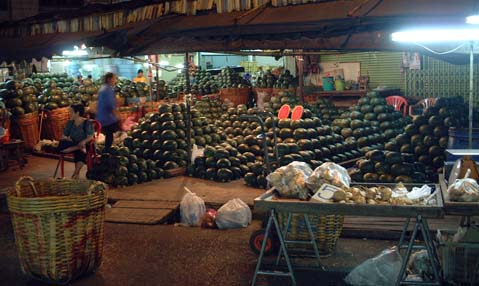 |
|---|
| Fruit market at Bo Bae |
We had dinner at a hotel restaurant when it was a ice-breaking time to some of us. Monica and Ivy were two lovely buddies, knowing each other since tertiary. Daphne kept us in suspense over her occupation and narrated untiringly about her son as a film producer. Accompanied her was the quiet Choo Inn who constantly nursed Daphne over her knee injury. Auntie Long, over her 70s, had travelled several countries alone despite her wrinkles and slow movements, her passion was well admired. Not to forget our Singapore guide called Samy in his thirty, who adhered his fashion preference of wearing a cap on top of which rested a pair of sunglasses day in and out everywhere. We lodged at Prince Palace Hotel in the Bo Bae district where the reception was uniquely located at the upper storey and below which were many retail garment shops.
Except travelling along jammed highway of Bangkok, we did not get to browse around at late hour. After checking in our room, Cheng and I sneaked out to the main road nearby which was straddled with rows of hawkers mat-laying fruits and vegetables of tantalizing colours. The fruit market, hustle in late hours, fully occupied two sides of roads separated by a river. We bought nothing but water supply and had a early night sleep before a long journey tomorrow.
Jan 20 (Bangkok, Poipet, Siem Reap)
The dawn started with a cooling drizzle, causing all the garment stalls just outside of Prince Palace Hotel to pitch their canvases high. The garment warehouse sale were opened as early as before six, where clothes were sold mainly in bulks. We boarded the same coach and travelled for three hours to the Thai-Cambodia border. Along the highway rows of Singapore and Thailand flags were hoisted side-by-side, signifying the welcome of our dear Singapore president's imminent arrival. Beside signs of international friendships, posters and banners of politicians were everywhere to prepare for a national cabinet election.
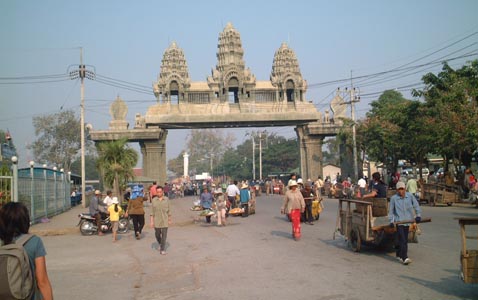 |
|---|
| Poipet |
Before noon, we found ourselves at Aranyaprathet, the nearest town from the border with sprawling markets and cafes. Under the hot sun, the group brought down their luggages to a 'Roll-Royce', self-acclaimed by Samy, which was practically a low-down handpull cartwheel. Cheng and I, light and mobile, strapped all our burden on two haversacks. The Thai immigration post was a shabby office accommodating merely two queues of tourists awaiting for the 'cross-country'. Crossing the Friendship Bridge spanned over the murky O Chrov Creek river, there were influx of homeless kid beggars, cart pullers, transporting trucks and roadside hawkers, bustling into a phenomenon of 'organised chaos'. We were now in Poipet, the no-man-land between Thailand and Cambodia, where gambling within several casino hotel was proliferated. It was declared as Asian Las Vegas but the poor road condition and not-so-impressive hotel layout showed otherwise. A facade craving 'Kingdom of Cambodia' topped with mock-up Khmer-styled towers of Angkor Wat remained us of a different nationality.
To get across Cambodia, we handed over our passports and tens of US dollars for immigration custom pass, including US$13 each just to get a stamp from the money-starving custom official. We had our buffet lunch at Grand Diamond hotel, one of the six so-called luxurious five-starred casino hotel. The restaurant was packed with hungry patrons who took breaks from their biddings on the deck tables or jackpots next door. My fear of travelling a smaller bus in the next six hours to Siam Reap came true. All the seats were taken up, including the backseats for our bulky luggages. Song, the Cambodian guide, was formerly introduced. In his twenty, he wore smart casual and looked introvert despite his tanned feature. Before a long journey along mainly dirt route, the bus was refuelled at the grocery shop selling plastic bottles of diesels. Two hours of ride was followed a toilet stop at Sisophon, a small plain town riddled with young people arm-carrying their siblings. A primary-school girl, with her limited command of English, pleaded for foreign coins from the urgent tourists waiting at the restrooms. She intended to consolidate all coins and then exchange for profitable dollar note; though I was impressed of her street-wise capability, I pitied her lost of innocence in the impact of tourism.
 |
|---|
| On the road less travelled... |
The remaining four hour of journey came no closer to comfort. As the landscape became more deserted with drought plain of brownish grass outstretching over the flat horizon, the road worsened with more loopholes and dusts. Occasionally, detours were made on the barren riverbed to avoid the collapsed steel bridges. The bus was impotent with suspension dampens; every bump woke everyone up or shook off camera focus. Cheng and I, sat at the back, constantly aware of any fallen of bulky shopping luggages whenever the bus swerved. I was guilty of my little complain as the outside images reminded me of how fortunate I was, even of getting some cool air from the vents. If we did not have an excursion along these mileages, we would not appreciate the magnitude of poverty, in this war-scarred country of high corruption and illiteracy, attained only 20 years of peace after Khmer Rouge occupation: naked toddlers playing barefooted on the sand on the dusty roadside, family bathing and washing around the well near their house built on wooden slits and attap roof smearing heavily with brown dust.
In the evening near the Siem Reap, the road improved drastically from unpaved to tarred. The road was lit up by the advertising neon lights from the rows of grand hotels of gold-tinted pointed Khmer-styled roofs or ornate duplicates of Angkor Wat structures, in shocking contrary of the poverty we witnessed few hours ago. Because Siem Reap provided a convenient stop to the widely-recognised Angkor artifacts, it was now a tourist paradise full of hotels and supermarts. We arrived late around eight to have an outdoor buffet dinner while entertained by cultural dances depicting of cheerful fishermen with their constant 'oh-ah' trying to impress the beloved rice-ploughing ladies, as well as Aparases (legendary as celestial temptress to please the godlike) dancers balanced on one leg while twisting their hands holding golden roses. Shockingly, we stayed in the big room of Goldiana Angkor Hotel providing every amenity we needed. I never expected such level of luxury, as given, was totally incongruent outside of Siem Reap.
Jan 21 (Angkor)
The dining hall was packed with swarms of Korean tourists in the onset of sunrise. To avoid the crowd, we strolled along the street already busy with commuting cyclists before we consumed our daily breakfast. Although I wished to set out as early as possible to tour the famous Angkor, I was conformed to wait for everyone as late as nine in the typical tour package. About seven km north of Siem Reap, each paid US$20 for one-day pass at the entry to the Angkor. Finally this was what I had been waiting for in this trip -- Angkor, the priceless artifact jewel which was founded by Jayavarman II in his Khmer Empire and ended its glory mysteriously in Jayavarman VIII regime, had been laid dormant within the jungle for centuries but was discovered during the French colonial times. (Some proclaimed proudly that it was one of the Seven Wonders. Angkor was undeniably outstanding. However, to me, the notion of Seven Wonder was too farfetched because to think that all the global civilizations or landscapes could be ranked only out of seven best, even without realising the world vastness or setting any standards for comparisons. There were definitely fascinating places counted beyond seven.)
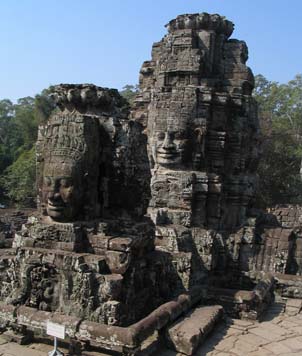 |
|---|
| Bayon |
We drove along the perimeter and got our first glimpse of towers of Angkor Wat, the most famous of all Angkor sites. But we skipped it in the morning and proceeded to south gate of Angkor Thom. At the roadsides, two rows of stone-craved god statues, most of which lost their limbs, looked sternly at all trespassers. The tower gate held four giant faces, resembled King Jayavarman VII, gazed high up at different directions. (See my sketch on the tower gate of Angkor Thom.)
Bayon, situated at the centre of the Angkor Thom, was the temple of Jayavarman VII. It contained several stony spires, of which each compass direction craved the face of Jayavarman VII with Buddha-like serenity. Song, the young Cambodia guide, brought our attention to southern Bayon bas-relief walls and narrated its depictions of ancient war between Khmer and Chams armies. It related me to my previous Vietnam trip which I witnessed the artifacts of Champa at My Son. Through the south gate of Bayon, we stood in front of a 45m high pyramid temple tower. Walking right to the east was two libraries at both flanks which were left with bricks, stones and now a resting place for tiring visitors. Negotiating through the stairway up to the central tower crowded with numerous Korean tourists, we were at a little maze of walls of ornate Aparas. There were inner passages, each of which some old lady caretakers would kindly invite anyone curious to pray with incenses in front of a Buddha statue in orange robe. Again we were greeted in all directions by the smiles of Jayavarman VII which its thick lips were curling up at both ends. The smile perhaps showed that he was pleased of the world acknowledgment finally after hundreds of dormant years; or proud of his lasting victory enduring against the onslaught of times and nature.Driving northwards, we came across Baphuon, a temple under renovation, built by Udayadityavarman II; and then the Terrace of the Elephants where walls of a huge platform were lined with propping elephant heads and half-bird half-man Garudas. Irresistible against the terrace ornate, we urged the driver to stop by for few minutes for some quick shootings. It was then mid-afternoon and the heat begun unbearable, a good opportunity to take our lunch and get some air-con breeze back in Siem Reap. Samy proposed to take us for a quick souvenir shopping before it was less heaty. Cheng and I had a bad experience with one of the group, who ridiculed the salewoman over US fifty cents and in turn belittled herself even more. Just hope that the locals who witnessed did not realise she was from Singapore, lest it was a total disgrace to the nation.
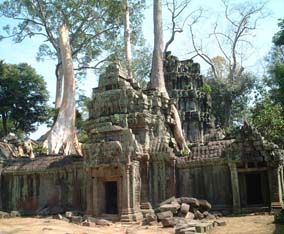 |
|---|
| Ta Prohm |
Continued to our exploration of Angkor, this time we visited Ta Prohm to appreciate why the Hollywood movie 'Tomb Raider' was shot here. Passing through a dirt path, we came across several landmine victims sat together in local orchestra despite their handicaps. It was mostly unmolested by human and preserved in its natural state. Fig, banyan and kapok tress embraced the temple in violent passion as their truck hug among the stony pillar, their roots outstretched in between the tiles and their branches and leaves hovered over the super structures. Because of the deep encroachment of nature, Ta Prohm was ruined with collapsed roots and uneven ground, yet of mighty authenticity. Likewise in Angkor Thom, there were intrinsic walls of seductive aparas, female divinities and mediating Buddha, often blurred by intertwining roots and green lichens. Such unusual balance between nature and artifacts was displayed unprecedently before me, I was deeply captivated. Sad to say, the mystic of such unique site was erode drastically by the invasion of massive tourists with full of giggles and flashes. Guess it would be quite a ghastly scene without human sight at night, but I did not have the guts nor luxury to come at late hour. We left at the opposite direction, where five shabby children happily clapped their hands and songs their lullaby in hope of some donations.
Finally, the most anticipated of all -- Angkor Wat before sunset. It was the finest and most intact monument of all to portray once-glorified Khmer empire. The landmark of Angkor Wat was the five towers symbolised the sacred Mt Meru and shaped like lotus buds. We were walking along the pathway from the entry terrace to the facade of three entry towers with collapsed roofs. It housed a tall stone figure of Buddha with orange rode, but was once a Vishnu image. Another visa-versa example was on the pictorial walls along a row of small meditating Buddha figures whose lotus-sitting legs were erased into criss-crossing ones like Hindu dancing. These signs of changing emphasis of faiths between Hinduism and Buddhism depended on the Khmer rulers' preference and devotion. At the far end of a long causeway, we saw the five central towers of Angkor Wat, so awesome that it was part of Cambodia flag. We diverted halfway along the causeway bordered by rows of serpent-like naga statues and was brought by Song to a field basin. Though the basin was only half-filled with water, the mosaic reflection of Angkor Wat towers was pretty magnificent. We cut across the causeway and went pass the cruciform Terrace of Honour to the Bas-relief galleries. At the first platform level, the perimeter walls were lavished with ornate Bas-relief depicting Khmer battles, either godlike or not. There was little opportunity to stare on the artwork for long since the corridor was in a heavy tourist traffic.
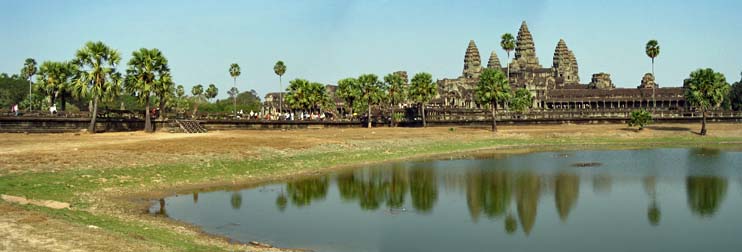 |
|---|
| Angkor Wat |
Proceeding furthur, we were at the second level of platform where the Hall of Echoes exhibited its unusual acoustics. They said by thumping your chest on the wall, strange resonance would render you best health. I was skeptical by unsound practice so I chose not to perform the strange act. As usual, there were no lack of craftings of Aparas and Budha images. Penetrating deeper, we were at the upmost level of Angkor Wat. The central sanctuary rose up 42m higher above that level. Cheng and I were the first ones attempted the ascent on all four limbs via the frighteningly steep staircase which its pave width was lesser than normal man's foot length. The sanctuary offered more spectacular view outside through the fake windows than those inside. There was only one of those staircase flights which provided railing for descending but the queue was disturbingly long. I tried to convince myself to climb down from other direction, but looking at the staircase which plunged outrageously steep down compelled me to obediently queue up like the normal rest. Why took the risk when I had a safer alternative? I thought initially. In the queue, we met one middle-aged guy who claimed to follow the same Thai-Cambodia path by biking for days with his fellow companions for a charity event. He was so plump that I hardly believed that he had been cycled through sweat and sand, not til he showed us his digital photographs of the event through the camera. This was one great man with admirable spirit who took the risk rather than the comfort for a greater cause. While queuing, a family of ordinary Cambodians crossed the line and tried to go down first. Either they had their local privileges or they were simply too uneducated to know the social codes of conduct, I did not understand and was initially pissed off . Then I thought, of many things they had without, perhaps we should at least let them have some convenient. The Cambodian father carried his young daughters in one arm, gripped the railing in another while grasping small footholds. Likewise, we followed the way down carefully and slowly, one step at a time. We then backtracked to the western gate, and I acquainted a cheerful girl who sat on a ledge and was drawing about the area on her jotter book. I boasted myself in front of her that I could draw nicely too by scribbling urgently on her previous book but in the end, I only ruined her artpiece and was repayed by a frown. How I wish I could send my post-trip sketch to her... We hopped on to the bus which immediately surrounded by teenager touts selling postcards and souvenirs, and swiftly, it zoomed to the Phnom Bakheng before sun set.
The temple of Phnom Bakheng was situated on a small hill, proclaimed to offer best sunset and sunrise views. It could be accessed by riding an elephant at a fee, or walking uphill on a relatively steep dirt path free-of-charge. Fiona, one of our group members, was so terrified that I held her hand during the ascent to build up her confidence on her first hill conquest. Not only did I need to wriggle on undulating terrain, I had to negotiate my way through many climbers as well. The rectangular temple consisted of five terraces built on top of one other. Once again, we had to move up along the steep flight of staircase, much like that of Angkor Wat. I was utterly disappointed by few things: first, the top level of temple was already filled with awaiting spectators and their noises at every corner; second, the sunset view, tainted by loud people, was on the opposite side of Angkor Wat; third, the overview of Angkor Wat was so far and small that I had to search a while to affirm its location. We then decided to return to our bus earlier before the human swarm came rushing down too. Going down sideway along the steep stony flight of steps without railing, we relied on the crevices in between the wall stones for hand grip. The descent down the hill slope was again an extra challenge as more visitors were competing for better foothold. Fiona expressed deep appreciated of my two-way hill escort, I shyly claimed no trouble at all based on my past climbing experience. Although this sight-seeing was below expectation, everybody was in high spirit thoughout the bus journey back to Siem Reap. This day trip on Angkor was concluded by another dinner associated with Aparas dance. Taking a peek of this architecture wonder paid off the border-crossing journey over hours, however, its mystic and serene was regretfully and drastically eroded by overwhelming tourists, not to mention it was merely a one-day trip forsaking many other hidden Angkor sites in this typical itinerary.
Jan 22 (Tonle Sap, Poipet)
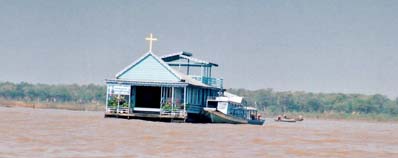 |
|---|
| Floating Cathedral |
After a hearty breakfast, we checked out the hotel and headed to Tonle Sap which was the largest freshwater lake in South east asia connecting to Mekong River. The road was straddled with ramshackled houses which was built mainly on attap and wood and levelled high by slits to avoid flooring. Due to the near water catchment, the grassland was lushing in green. Residential children, baggily dressed or even naked, waved innocently at our arrivals. Poverty was vividly displayed. The entry where we were going to hitch a boat was already jammed with other tourist buses. At the river shore littered with rubbish and children begging for anything, it was also bustling with workers loading up stinky fish buckle to the truck and in contrast, men playing leisurely at the pool tables in the open. We walking along a wooden plank to our sampan-like boat with bamboo seats for an excursion to the Tonle Sap lake. The stream was actually a unique village made up of residential houses, grocery shop, kid school, a police station and even a Cathedral, all floating on the water! The villagers, set their home off the land to evade the tax, frequently shifted their lowdown attap houses during high-tide season. Daily living activities were everywhere. Sturdy-built fisherman stood silently on the boat, waiting to spread his net when spotted any fish. Uniformed children rowed their boat on their way to school. Middle-aged auntie loaded their purchased items to their boat from the grocery shop. It was amazing to find a community which would never have seasick problem. As we glided through the stream in heavy boat traffic, we had to beware of other vessel motor splashing those muddy water onboard.
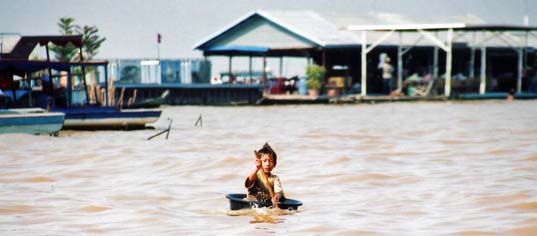 |
|---|
| Boy in tub |
In an hour or less, we arrived at the Tonle Sap lake, which its vast horizon was easily mistaken as sea. Song, the same Cambodian guide, claimed it had inlet to the capital of Phnom Penh. There were restaurants serving the tourists for a lake view. Some kids were sitting individually on a tiny tub, diligently rowing their oars just to gain small distance in the open water. Singaporean parents would faint if their children were doing likewise! It was so hilarious to watch those little souls, so we lured one of them to our sides for closer snap-shooting. A tanned boy rowed eagerly towards us with his small boat which carried his little brother opening his hands for gifts. Both brothers were pleased and speechless to receive stationery and sweets form us, and were more than willing to put up a hand sign of 'V' in front of our lens. We did not stop at any of those touristy restaurants for a longer lake view or meal, instead we headed back to the same route. Once touched on the land, Auntie Long took out her bag full of sweets, immediately kids swarmed around her, pushing her for more even after they had their shares. Cheng and I tried to control this little commotion by bringing her to the bus. To chase those greedy eyes and hands away, Auntie Long threw the sweets away at the distance over the ground. Personally I disagreed her throwing action much like towards some stray dogs, considering dignities of those kids. With hindsight, I could not blame her too as her passion of sharing surpassed any of us. Did I mention that she brought a large luggage filled with stuffs just to be distributed to the poor in Cambodia?
We had some remaining time to visit a handicraft centre called Le Artisans D'Angkor which was set up by some youth society to impart crafting skills to the rural adolescents. Receiving little educations before, these young people appreciated this rare skill-learning opportunity. It was evident as they industriously trimmed and craved wooden block out into Buddha heads, and concentrated fully on gilding copper leaves on wooden pieces pictured of Aparas. Cheng and I bought two t-shirts, merely showing a tiny gesture of supporting this centre providing a second chance. Then there was this buffet meal again at a spacious restaurant. There were so many food variety that some of us regretted having only one stomach. It was kind of guilty that while the locals were hard to get some less than decent meals, here we were stuffing the food and had leftovers. Though I belonged to a middle-class person who worked through days for a living, I could not appreciate the hardship or content these people had been going through everyday. I felt helpless, somehow.
We made last-minute shopping at an open-air market selling souvenirs and postcards before we left Siem Reap for good. It was six hours of rough ride back to Poipet, to which none of us was looking forwards. Aware of countless bumps on the rocky roads in day two, the journey bothered us less. To kill the time, I chatted with Fiona and Monica, new friends within the group. In Sisophon town, Song kindly brought us to a small example of killing field. It was actually a Buddhist monastery which turned into a Khmer Rouge headquarter during the Pol Pot's reign of terror, hence many educated or oppositions were executed here. Now, hundreds of their fragmented skulls and bones were piled high up in a commemorated cell, beside a Buddha statue and a Bohi tree to appease their souls. In this holocaust of 70s, almost half of the populations were killed by own Cambodians under the name of Maoist-style agrarian society, making notorious killing fields and minefields everywhere. Such infinity of sorrows and injustices were hard to grasp, but I was glad that this country, though still developing, had attained peace at last like Vietnam for the children to roam around and play. We met some kids at the killing field site and they humbly thanked us for the sweets. Their lives would be better than their parents and grandparents, but staying near such place as a gruesome lesson, they might not take peace for granted.
We lodged at the Grand Diamond casino hotel in the no-man-land of Poipet. Cheng and I took a tour around the jackpots and roulette wheels. We did not have a single trace of interest towards getting some chips since we knew our statistic and did not want to waste our luck for some cheap gains, so we resorted to our rooms watching television after our dinner.
Jan 23 (Poipet, Bangkok)
I was astonished to find a large influx of people and cartwheels already streaming towards Thai border as early as six. We walked across the border to the Cambodian custom office and witnessed a flag-raising ceremony which the locals never stopped for a moment and wasted no time performing their hard-earned living. For example, a young girl had one arm cuddling her little sister and another raising her umbrellas to shade either one of us, seeking for petite coins. After crossing the border to the Aranyaprathet of Thailand, each of us had a souvenir of two passport stamps from different countries in a single trip. We were glad to see Ning, the Bangkok lady guide and even more delighted to sit on the big coach bus again. I started to appreciate the tar road condition in Thailand which our bus speeded better for three hours to Bangkok. During the ride, some of us had our gossip corner. Apparently someone was refused from her room last night after her late massage session, by her roommate, who happened to be the same distasteful one arguing nonsensibly at the souvenir shop during Angkor tour. This roommate of hers, selfishly possessed the only room key and refused to let her enter while she had to bang madly the door which was locked from within. It turned out many of us disapproved her attitude and behavior, not to mention her likewise rude mother after witnessing many of their offending gestures such as rejecting the elderly Auntie Long for a seat. Like mother, like daughter, they doubtlessly should be awarded as the typical kiasu self-centred couple. I doubted they had any single feelings towards the sights of poverty days before since they were too occupied fulfilling their comforts and conveniences. Many tours they should allow to go, I just wish dearly that they never identified themselves as Singaporeans because they were the growing minority who should be incinerated for the betterment of mankind. I rested my case...
The rest of the day in Bangkok was pretty normal. After a compulsory visit to the ruby-crafting centre brilliant with real-stuff jewelry for the riches, some of us took a free ride to MBK Centre, a fascinating shopping mall which made all hard-cored shoppers screams. Cheng and I bought some dried food stuff in a small crate. I surfed the Internet to ease my itch to technology and latest information about stocks. Ah yes, I started to invest in shares but no, I was not into golfing. When Cheng and I checked into the Prince Palace Hotel, we were surprised to find our room big enough to have a little conference. It was uncomfortably spacious, especially when I became to feel uncomfortable in my stomach and had to make many corner turns to get to the toilet.
Jan 24 (Bangkok)
Cheng and I planned originally to visit the must-see Grand Palace before the flight at 1800hr. However, my stomach grunted and our plan were cancelled unfortunately. My pathetic condition forbade me to travel far. With slight recovery, I left the room in the afternoon for lunch and shopped for dirt-cheap dresses at the nearby garment mall. Guess I should have thumped my chest in the Angkor for health bliss. I was pretty sure I did not have any bird flu which currently started to invade Thailand again. It was diagnosed later to be stomach flu which stuck me without cause and later at Cheng during the return flight. This incident gave the group an excuse to tease me as a young man with weak stomach. Despite of all the rough trips I had been through, I think I should admit that status...